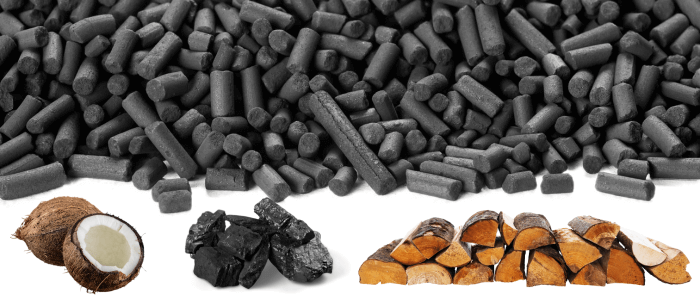What are activated carbon pellets?
Activated carbon pellets are highly porous granules or pellets made from carbon-rich materials like coal, wood, coconut shells, or other carbon sources. They are subjected to an activation process, usually through heat treatment at high temperatures in the presence of steam or carbon dioxide, which creates a network of pores and increases their surface area. This unique structure enables them to effectively adsorb and capture a wide range of impurities, contaminants, and pollutants from gases or liquids.
What is activated carbon pellets made of?
Activated carbon pellets are primarily made from carbonaceous materials, such as coal, wood, coconut shells, or other organic sources rich in carbon. These raw materials undergo a series of controlled processes, including carbonization and activation, to create the porous structure characteristic of activated carbon pellets.How to make activated carbon pellets?

The production of activated carbon pellets involves several key steps. Firstly, the carbonaceous material is carbonized at high temperatures in the absence of oxygen, which removes volatile compounds and leaves behind a carbon-rich substance. Then, the carbonized material undergoes an activation process. Activation is achieved by exposing the carbonized material to high temperatures (800-1000°C or 1472-1832°F) and activating agents like steam or carbon dioxide. This process creates a vast network of pores, enhancing the surface area and adsorption capacity of the material. The activated material is then processed into pellets or granules, forming activated carbon pellets.
Are activated carbon pellets the same as activated charcoal?
.png)
Activated carbon pellets and activated charcoal are often used interchangeably as they serve similar purposes. Both are forms of activated carbon with highly porous structures used for adsorption and purification. However, their physical forms may differ. Activated charcoal might be in the form of powder, while activated carbon pellets are in granular or pellet form. Despite the difference in appearance, they share similar properties and are utilized for various filtration and purification applications.
What are activated carbon pellets used for?
Activated carbon pellets have a wide range of applications due to their excellent adsorption properties. They are extensively used in industries such as water treatment, air purification, gas and odor control, chemical processing, pharmaceuticals, food and beverage, and more. Common uses include removing impurities from water (like chlorine, volatile organic compounds, and contaminants), purifying air by adsorbing odors and gases, and facilitating purification processes in industries like pharmaceuticals and food processing.
How to use activated carbon pellets?
The usage of activated carbon pellets depends on the intended application. Generally, they can be placed in filtration systems or containers designed for water or air purification. For water treatment, activated carbon pellets can be added to filters or cartridges to remove impurities. In air purification, they're used in air filters or air purifiers. Follow manufacturer guidelines for specific applications, as the usage might vary based on the intended purpose and the system used for purification or filtration.
FAQ about activated carbon pellets
Where to buy activated carbon pellets?
Activated carbon pellets can be purchased from several sources, offering different options and quantities. Consider checking specialty stores that focus on water treatment or industrial supplies, both in physical locations and online. Additionally, online retailers such as Amazon, eBay, or specific filtration equipment suppliers' websites offer a wide variety of activated carbon pellets. You can also explore purchasing directly from manufacturers specializing in activated carbon products, either through their websites or by contacting them directly. Ensure to review product specifications, particle sizes, and intended applications before making a purchase to ensure it aligns with your specific needs.• Specialty stores
• Online retailers
• Chemcial suppliers
• Direct from activated carbon manufacturers
How to use activated carbon pellets in an aquarium

Using activated carbon pellets in an aquarium is straightforward. Place the pellets in a mesh or filter bag after rinsing them to remove any fine particles. Position the bag in your aquarium filter or a spot with good water flow. This allows the pellets to absorb impurities, odors, and discoloration from the water, promoting clearer and cleaner conditions for your aquatic pets. Remember to replace the pellets regularly, typically every 3-4 weeks, to maintain their effectiveness in keeping the aquarium water clean without stripping essential nutrients needed for a healthy aquatic environment.

